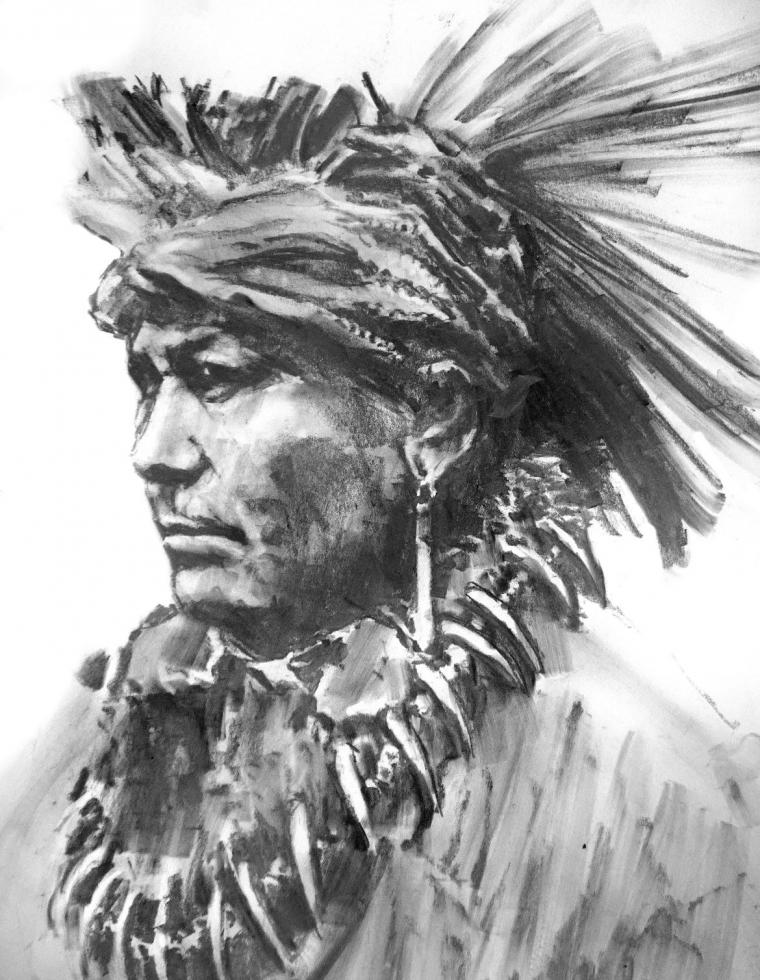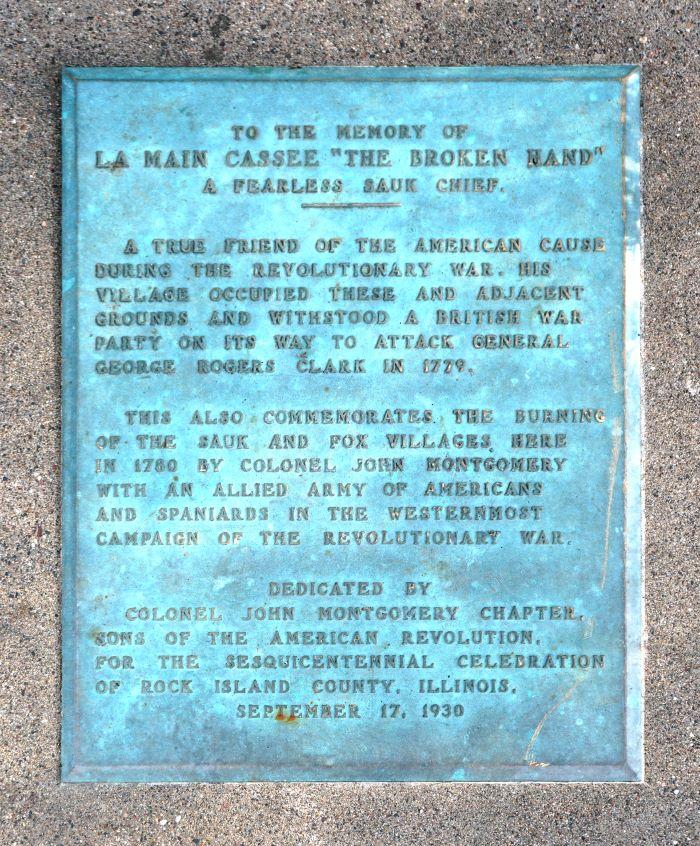
La Main Cassee drawing by Bruce Walters
To the Memory of
La Main Cassee “The Broken Hand”
a Fearless Sauk Chief
These are the first words on an historic marker at the Black Hawk Historic Site in Rock Island.
The marker states that La Main Cassee was “a true friend of the American cause during the Revolutionary War“ who confronted a British war party here in 1779. The same marker then commemorates the burning of Saukenuk by the American military in 1780.
To make some sense of why the village that stood on this site was destroyed by the Americans – especially when they had praised them just one year before – we need to see this tragedy in context with the Sauk and their relationship with the British and Americans.
The Sauk people arrived in present-day Rock Island just two generations before the American Revolution. They had been pushed westward from the St. Lawrence River to Saginaw Bay and then to Wisconsin and Illinois by neighboring tribes over the course of 150 years. The Sauk trapped animals for their fur during the winter. They traded these furs, primarily, with the British.
La Main Cassee’s name first appears in a journal by Captain Charles Gautier, a British captain who attempted to align Native American tribes in the western Great Lakes region with British imperial interests.
In April of 1779, Gautier came across a band of the Sauk on the Rock River. Their leader, La Main Cassee, “personally withstood a British force of 280 men and compelled the officer to release 120 of the warriors.” The British officer, however, also observed another Sauk band who were aligned with him against the Americans.
In May of 1780, British and Indian allies – including the Sauk who opposed La Main Cassee – attacked St. Louis. They failed to capture the Spanish fort and other targets near St. Louis. The victorious American commander pursued the retreating warriors up the Illinois River and destroyed their villages. The Sauk and their allies could muster 700 warriors, but they were disbanded and unable to defend their towns.
Black Hawk was about 12 years old when his village was burned to the ground. He would later fight alongside British troops in the War of 1812, defeating the Americans at the Battle of Credit Island and the Battle of Rock Island Rapids. When the war ended, the American army built a fort on Arsenal Island to contain him. He would be brought back to this fort in custody when the Black Hawk War ended in 1832. An estimated 4,800 Sauk and Fox people lived in the village before the war. It was the largest single settlement in the new U.S. state of Illinois.
In gathering information from all of the resources available to me, I couldn’t find anything about La Main Cassee as a person. No portraits or information about his birth, death, or grave site.
We know, however, that he lived in Saukenuk village, and that the bluff where this marker is placed was important to the people who lived here. In my mind, the marker serves as a cenotaph, standing as a testament to the complex and interconnected history of the Sauk people and us, who live in the present on the same land.
Bruce Walters is a Professor Emeritus in Art conferred by Western Illinois University.
This is part of an occasional series on famous (or infamous) people buried in cemeteries in the Quad Cities, and their history that is not so well-known today. If there’s a piece of history buried here that you’d like to learn more about, e-mail the location and a brief description to BD-Walters@wiu.edu.

La Main Cassee Appreciation: 1930 Sesqui-Centennial Souvenir Program
By John Hauberg
The principal chiefs of this locality were said to favor the British, and had early rallied at Montreal with a following from this place. Sauk and Fox Indians were listed among those who marched with Burgoyne in 1777 in his campaign which ended in defeat at Saratoga. To the end of the war our Indians were still found in the British service.
There was one outstanding Sauk chief, however, who doubtless had found his friendships among the trading centers to the south, and who soon ''received the belt of the Bostonians." In other words, he attached himself to the American cause. This was La Main Cassee, The Broken Hand. Around this personality there arose contentions which lifted this locality high out of the ordinary humdrum of Revolutionary War events.
La Main Cassee's first recorded thorn in the British flesh was at Prairie du Chien, where he arose in council, as British recruiting was progressing, and '^without reserve" denounced the Briton, and ''kept many from going down." He sent his delegations to the tribes inhabiting the Great Lakes and Upper Mississippi River region, and kept things there in more or less of a turmoil. In one of the councils on the Wisconsin river, three of his men broke up the meeting, and caused the British officer to be stripped of his regimentals. Capt. Bowman of the Americans was purchasing horses of the Sauk and Fox soon after the arrival of Clark in the Illinois, while at his village here, in 1779, Cassee personally withstood a British force of 280 men, and compelled the officer to release 120 of the warriors, and, said the British officer, “'I believe that, had he been strong enough, he would have taken me and delivered me to the Americans.”
These actions of La Main Cassee's did not go unnoticed by the British and their Indian allies. The Sioux, who were most zealous for the British cause, sought permission, in 1779, to attack the Sauk town at Rock Island, to punish La Main Cassee. Again, in 1780, messengers came from Detroit to inform him that unless he joined the British, "War will be declared upon you by all other (Indian) nations and by the troops of the king." The British authorities sought to compel him to change his ways by threatening to cut off the traders, a threat which called forth only ridicule from this son of the forest.
There are items of far greater importance in the cause of the revolutionists. One is that of ammunition for the Continental armies. Military supplies had formerly come from England. Now they must be found elsewhere. We find in a single item, where nine thousand pounds of powder were successfully brought up the Mississippi and Ohio rivers, from New Orleans, and delivered at Fort Pitt – now Pittsburgh. This was in 1776-7. British officers in the west repeatedly complained of the traffic in lead, on the part of the Sauk and Fox of Rock Island, who were trading it down the river, and in 1780 alone, the British ''stopped 50 tons of lead intended for the rebels" at the Sauk and Fox mines. The extent to which the Americans looked to the mines of these Indians for their bullet supplies, is one of the unwritten chapters of the war.
There are three instances which call for particular notice, locally. One has been mentioned above – that of La Main Cassee at his village here, virtually breaking up a war party under Capt. Charles Gautier, in 1779, on his way to attack General Clark. Of much greater import is the charge brought against these Indians, in 1780, where blame for the British defeat at St. Louis and Cahokia is laid at the feet of these Rock Island Indians, and lastly, the event where the principal chiefs of the Sauk and Fox, who have been serving with the British, are punished by the burning of their towns here, by Col. John Montgomery, under orders of George Rogers Clark.
It is fitting that Rock Island County should celebrate. Upon the pleasant bluffs and by the shores of the Mississippi and Rock Rivers, lie buried many a daughter and son of the revolution, of dusky complexion, followers of La Main Cassee, and for all we know, it may have been – as charged by the British – their loyalty and labor which kept the Illinois country under the Stars and Stripes.










